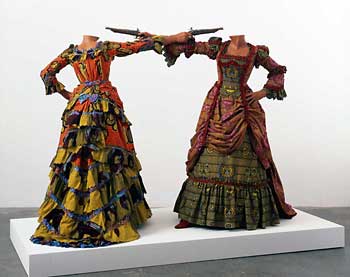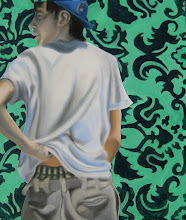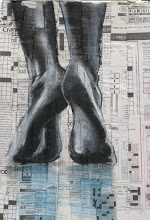Overview: Advanced Placement Art history is a college level course that enables students to apply decision-making, analytical and problem-solving skills that will facilitate rational, effective lifelong learning. Students who successfully complete the requirements can request credit from the college or university they will attend. Credit will be awarded upon passing the AP Art History exam by the AP College Board.
Course Objectives:
Students will learn to discuss and write about art using skills that define critical thinking, including analysis, inference, interpretation, compare and contrast and evaluation.
Students will also learn how to use critical thinking skills to make connections from concrete to abstract, personal to impersonal and literal to figurative.
Students will gain an understanding of different cultural traditions through art as a reflection of those societies.
Students will learn to see through observing details in the art studied. Students will learn to relate those details to observation of their own world.
Students will observe the evolution of art and societies through the chronological approach to teaching of art history.
Students will develop an art vocabulary and be able to use the language of painting, sculpture and architecture and also the Elements of Art and the Principles of Design. They will also learn technical terms, stylistic devices and building methods.
Students will have an opportunity to experience hands-on approaches to various media and processes including fresco and construction for a better understanding of the arts.
Because of the religious purpose of much of the art studied, students will develop a basic knowledge of world religions and their relationship with art.
Students will make connections to literary works through paintings and sculptures as narrative forms of expression.
Students will come to understand the business of art and the patronage necessary for much of art’s “creation”.
Student Learning:
During the year of study students will learn to:
do rigorous homework and reading assignments in college level texts
in-depth study and analysis of hundreds of works of art
develop an art, art history and technique vocabulary
analyze works of art and determine styles, time periods and influences
understand historical facts through fine art images
participate in classroom discussions
do formal analysis using the elements and principles and composition
research and interpret works of art
understand world cultures and religions
make connections between cultures
develop learning through supporting the arts (museum and gallery attendance)
organize information through daily notes and lectures, texts and slides
write comparison essays using visual prompts (slides)
present orally in class using a variety of media and technology
formally analyze paintings through color reproductions
AP Art History Textbook List:
Texts provided: Gardner’s Art Through the Ages, Kleiner, Mamiya, Eleventh Edition, Thomson/Wadsworth
Supplemental: Arts and Ideas, Mary Warner Marien and John Fleming, Thomson/Wadsworth
Art Past, Art Present, Wilkins, Schultz & Linduff, Prentice Hall/Abrams
Art History, Marilyn Stokstad, Prentice hall/Abrams
Internet Resources: www.collegeboard.org/ap/art
www.collegeboard.com/apcentral
http://www.the-artfile.com/
http://www.nga.gov/
http://www.metmuseum.org/
Art History Concepts:
At the beginning of the year an overview of basic concepts is necessary to insure all students are on the same track with what the areas of study will be and where concerns come from. The following is a list of questions and answers that will be asked and instilled for greater understanding of art history.
· What is Art? What is Culture? Where does Art come from? What does Art do? (function and purpose)
· Ways of looking at Art and basic questions to ask when looking at works of art:
1. What is your first response to what you see?
2. When and where was the art made?
3. What area/space was the work originally intended for?
4. What was the purpose of the art?
5. How did the work survive and in what condition?
6. What is the title of the piece?
AP Art History Homework Assignments:
Homework will be assigned at the end of every week. Reading relevant pages in the art history text and note taking are required. There will be a list of vocabulary terms and students are required to define them as they appear in the text. Ideas and Concepts for every period of art history will be discussed with a series of questions pertinent to the readings included ever week. There is a substantial amount of reading and homework and weekly tests and quizzes. This is not a course for sissies.
Test, Quizzes, Essays:
Every week students will be given a quiz relevant to works being studied, using the AP exam format with side-by-side comparisons and/or slide identification and essays. Tests will be given at the end of each unit with short answer questions, slide identification, context questions and essays. Students will be expected to recognize concepts, images, dates, titles, names of the artists where appropriate, techniques, materials location/place, function of the art and styles. Students should be able to discuss art in all formats using the Elements and Principles and understand historical events that might have shaped the works of art. Finally, students should also be able to recognize and discuss characteristics of the various styles.
Grades:
Homework: 60%
Quizzes/Essays/Tests: 25%
Projects: 15%
Late work:
Excused absence – 2 days for completion, no point loss
Unexcused absence – 1 day for completion with point reduction equal to 20% of grade
Advanced Placement Art History Contract 2011-12:
I have read the purpose, responsibilities, fee and grading requirements of the Bowie High School Advanced Placement Art History Contract. I understand and agree to all the terms and conditions of this contract:
Student: _____________________________________________
Parent: _____________________________________________
Date: _____________________________________________
Sunday, August 21, 2011
Subscribe to:
Post Comments (Atom)








No comments:
Post a Comment